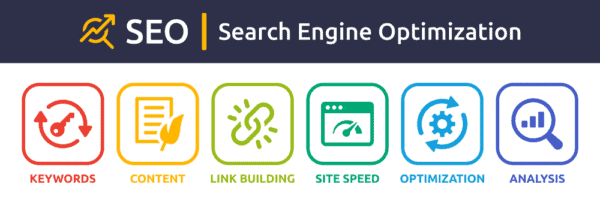The Ultimate SEO Checklist: Essential Steps to Skyrocket Your Website’s Visibility
In the fast-paced digital landscape, having a strong online presence is crucial for the success of any business or website. Search Engine Optimisation (SEO) plays a pivotal role in ensuring that your website is easily discoverable by search engines and, consequently, by your target audience.

To help you navigate the complex world of SEO, we have compiled the ultimate SEO checklist – a comprehensive guide to enhance your website’s visibility and drive organic traffic. Follow these 10 essential steps to take your SEO game to the next level.
1. Keyword Research and Strategy:
The foundation of any successful SEO campaign begins with thorough keyword research. Identify relevant keywords and phrases that your target audience is likely to search for. Utilize tools like Google Keyword Planner, SEMrush, or Ahrefs to find high-traffic and low-competition keywords. Once you have a list, strategically incorporate these keywords into your content, titles, meta descriptions, and headers.
2. On-Page Optimisation:
Optimize your individual pages for search engines by focusing on on-page elements. Ensure that your title tags, meta descriptions, and headers are not only keyword-rich but also compelling and relevant. Create high-quality, valuable content that satisfies the user’s intent. Use descriptive and SEO-friendly URLs, and don’t forget to include multimedia elements like images and videos to enhance user engagement.
3. Mobile Optimisation:
With the increasing use of mobile devices, optimising your website for mobile is no longer an option but a necessity. Google prioritizes mobile-friendly websites in its search rankings. Make sure your website is responsive, loads quickly on mobile devices, and provides a seamless user experience across various screen sizes.
4. Technical SEO:
Addressing technical aspects is crucial for search engine crawlers to effectively index your site. Conduct regular site audits to identify and fix issues like broken links, duplicate content, and crawl errors. Optimize your website’s loading speed by compressing images, leveraging browser caching, and minimizing server response time. Create and submit a sitemap to search engines for efficient crawling and indexing.
5. Link Building:
Quality backlinks remain a powerful factor in SEO. Develop a robust link-building strategy to acquire high-quality, authoritative backlinks. Guest posting, influencer outreach, and creating shareable content are effective methods for building a diverse and strong link profile. Monitor your backlink profile regularly and disavow any toxic or spammy links to maintain a healthy link profile.
6. Content Creation and Optimisation:
Content is king in the digital realm. Regularly create high-quality, relevant, and valuable content that addresses the needs and interests of your target audience. Use a mix of formats, including blog posts, infographics, videos, and more. Optimise your content for search engines by incorporating relevant keywords naturally and providing a clear structure with headers and bullet points.
7. Social Media Integration:
Social signals are becoming increasingly important in SEO. Establish a strong presence on relevant social media platforms to increase brand visibility and drive traffic to your website. Share your content on social media, encourage social sharing, and engage with your audience. Social signals may not have a direct impact on rankings, but they can contribute to increased brand awareness and indirectly influence SEO.
8. User Experience (UX):
A positive user experience is not only important for retaining visitors but also for SEO. Google considers factors such as bounce rate, dwell time, and click-through rate when determining rankings. Optimize your website’s navigation, ensure fast load times, and create a user-friendly interface. Provide valuable and easy-to-consume content that encourages users to spend more time on your site.
9. Local SEO:
If your business operates locally, optimizing for local search is essential. Claim and optimize your Google My Business listing, ensuring that your business information is accurate and up-to-date. Encourage customer reviews, respond to queries, and use local keywords in your content. Local SEO tactics help your business appear in local search results, attracting nearby customers.
10. Regular Monitoring and Analytics:
SEO is an ongoing process that requires constant monitoring and adjustment. Use tools like Google Analytics, Google Search Console, and other SEO analytics platforms to track your website’s performance. Monitor keyword rankings, traffic sources, and user behavior. Analyze the data to identify areas for improvement and adjust your SEO strategy accordingly.
Implementing the ultimate SEO checklist is a comprehensive approach to improving your website’s visibility and driving organic traffic. Remember that SEO is a dynamic field, and staying abreast of industry trends and search engine algorithm updates is crucial. By consistently applying these essential steps, you can build a strong foundation for a successful SEO strategy that will help your website rank higher in search engine results and attract the right audience.





